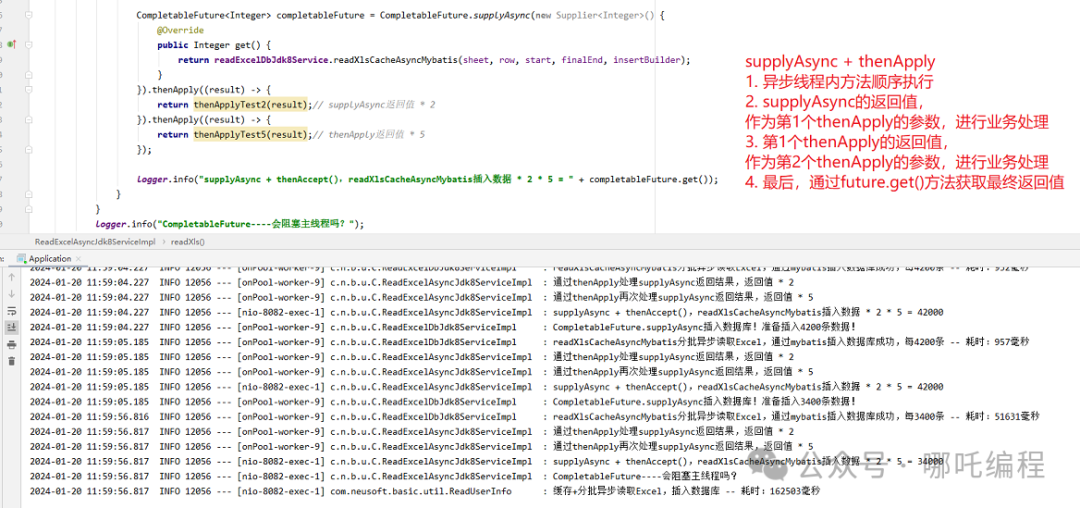
一、前情提要
在上一篇文章中,使用双异步后,如何保证数据一致性?,通过Future获取异步返回值,轮询判断Future状态,如果执行完毕或已取消,则通过get()获取返回值,get()是阻塞的方法,因此会阻塞当前线程,如果通过new Runnable()执行get()方法,那么还是需要返回AsyncResult,然后再通过主线程去get()获取异步线程返回结果。
写法很繁琐,还会阻塞主线程。
下面是FutureTask异步执行流程图:

二、JDK8的CompletableFuture
1、ForkJoinPool
Java8中引入了CompletableFuture,它实现了对Future的全面升级,可以通过回调的方式,获取异步线程返回值。
CompletableFuture的异步执行通过ForkJoinPool实现, 它使用守护线程去执行任务。
ForkJoinPool在于可以充分利用多核CPU的优势,把一个任务拆分成多个小任务,把多个小任务放到多个CPU上并行执行,当多个小任务执行完毕后,再将其执行结果合并起来。
Future的异步执行是通过ThreadPoolExecutor实现的。

2、从ForkJoinPool和ThreadPoolExecutor探索CompletableFuture和Future的区别
- ForkJoinPool中的每个线程都会有一个队列,而ThreadPoolExecutor只有一个队列,并根据queue类型不同,细分出各种线程池;
- ForkJoinPool在使用过程中,会创建大量的子任务,会进行大量的gc,但是ThreadPoolExecutor不需要,因为ThreadPoolExecutor是任务分配平均的;
- ThreadPoolExecutor中每个异步线程之间是相互独立的,当执行速度快的线程执行完毕后,它就会一直处于空闲的状态,等待其它线程执行完毕;
- ForkJoinPool中每个异步线程之间并不是绝对独立的,在ForkJoinPool线程池中会维护一个队列来存放需要执行的任务,当线程自身任务执行完毕后,它会从其它线程中获取未执行的任务并帮助它执行,直至所有线程执行完毕。
因此,在多线程任务分配不均时,ForkJoinPool的执行效率更高。但是,如果任务分配均匀,ThreadPoolExecutor的执行效率更高,因为ForkJoinPool会创建大量子任务,并对其进行大量的GC,比较耗时。
三、通过CompletableFuture优化 “通过Future获取异步返回值”
1、通过Future获取异步返回值关键代码
(1)将异步方法的返回值改为Future<Integer>,将返回值放到new AsyncResult<>();中
@Async("async-executor")
public void readXls(String filePath, String filename) {
try {
// 此代码为简化关键性代码
List<Future<Integer>> futureList = new ArrayList<>();
for (int time = 0; time < times; time++) {
Future<Integer> sumFuture = readExcelDataAsyncFutureService.readXlsCacheAsync();
futureList.add(sumFuture);
}
}catch (Exception e){
logger.error("readXlsCacheAsync---插入数据异常:",e);
}
}@Async("async-executor")
public Future<Integer> readXlsCacheAsync() {
try {
// 此代码为简化关键性代码
return new AsyncResult<>(sum);
}catch (Exception e){
return new AsyncResult<>(0);
}
}(2)通过Future<Integer>.get()获取返回值
public static boolean getFutureResult(List<Future<Integer>> futureList, int excelRow) {
int[] futureSumArr = new int[futureList.size()];
for (int i = 0;i<futureList.size();i++) {
try {
Future<Integer> future = futureList.get(i);
while (true) {
if (future.isDone() && !future.isCancelled()) {
Integer futureSum = future.get();
logger.info("获取Future返回值成功"+"----Future:" + future
+ ",Result:" + futureSum);
futureSumArr[i] += futureSum;
break;
} else {
logger.info("Future正在执行---获取Future返回值中---等待3秒");
Thread.sleep(3000);
}
}
} catch (Exception e) {
logger.error("获取Future返回值异常: ", e);
}
}
boolean insertFlag = getInsertSum(futureSumArr, excelRow);
logger.info("获取所有异步线程Future的返回值成功,Excel插入结果="+insertFlag);
return insertFlag;
}2、通过CompletableFuture获取异步返回值关键代码
(1)将异步方法的返回值改为 int
@Async("async-executor")
public void readXls(String filePath, String filename) {
List<CompletableFuture<Integer>> completableFutureList = new ArrayList<>();
for (int time = 0; time < times; time++) {
// 此代码为简化关键性代码
CompletableFuture<Integer> completableFuture = CompletableFuture.supplyAsync(new Supplier<Integer>() {
@Override
public Integer get() {
return readExcelDbJdk8Service.readXlsCacheAsyncMybatis();
}
}).thenApply((result) -> {// 回调方法
return thenApplyTest2(result);// supplyAsync返回值 * 1
}).thenApply((result) -> {
return thenApplyTest5(result);// thenApply返回值 * 1
}).exceptionally((e) -> { // 如果执行异常:
logger.error("CompletableFuture.supplyAsync----异常:", e);
return null;
});
completableFutureList.add(completableFuture);
}
}@Async("async-executor")
public int readXlsCacheAsync() {
try {
// 此代码为简化关键性代码
return sum;
}catch (Exception e){
return -1;
}
}(2)通过completableFuture.get()获取返回值
public static boolean getCompletableFutureResult(List<CompletableFuture<Integer>> list, int excelRow){
logger.info("通过completableFuture.get()获取每个异步线程的插入结果----开始");
int sum = 0;
for (int i = 0; i < list.size(); i++) {
Integer result = list.get(i).get();
sum += result;
}
boolean insertFlag = excelRow == sum;
logger.info("全部执行完毕,excelRow={},入库={}, 数据是否一致={}",excelRow,sum,insertFlag);
return insertFlag;
}3、效率对比
(1)测试环境
- 12个逻辑处理器的电脑;
- Excel中包含10万条数据;
- Future的自定义线程池,核心线程数为24;
- ForkJoinPool的核心线程数为24;
(2)统计四种情况下10万数据入库时间
- 不获取异步返回值
- 通过Future获取异步返回值
- 通过CompletableFuture获取异步返回值,默认ForkJoinPool线程池的核心线程数为本机逻辑处理器数量,测试电脑为12;
- 通过CompletableFuture获取异步返回值,修改ForkJoinPool线程池的核心线程数为24。
备注:因为CompletableFuture不阻塞主线程,主线程执行时间只有2秒,表格中统计的是异步线程全部执行完成的时间。
(3)设置核心线程数
将核心线程数CorePoolSize设置成CPU的处理器数量,是不是效率最高的?
// 获取CPU的处理器数量
int curSystemThreads = Runtime.getRuntime().availableProcessors() * 2;// 测试电脑是24因为在接口被调用后,开启异步线程,执行入库任务,因为测试机最多同时开启24线程处理任务,故将10万条数据拆分成等量的24份,也就是10万/24 = 4166,那么我设置成4200,是不是效率最佳呢?
测试的过程中发现,好像真的是这样的。
自定义ForkJoinPool线程池
@Autowired
@Qualifier("asyncTaskExecutor")
private Executor asyncTaskExecutor;
@Override
public void readXls(String filePath, String filename) {
List<CompletableFuture<Integer>> completableFutureList = new ArrayList<>();
for (int time = 0; time < times; time++) {
CompletableFuture<Integer> completableFuture = CompletableFuture.supplyAsync(new Supplier<Integer>() {
@Override
public Integer get() {
try {
return readExcelDbJdk8Service.readXlsCacheAsync(sheet, row, start, finalEnd, insertBuilder);
} catch (Exception e) {
logger.error("CompletableFuture----readXlsCacheAsync---异常:", e);
return -1;
}
};
},asyncTaskExecutor);
completableFutureList.add(completableFuture);
}
// 不会阻塞主线程
CompletableFuture.allOf(completableFutureList.toArray(new CompletableFuture[completableFutureList.size()])).whenComplete((r,e) -> {
try {
int insertSum = getCompletableFutureResult(completableFutureList, excelRow);
} catch (Exception ex) {
return;
}
});
}自定义线程池
/**
* 自定义异步线程池
*/
@Bean("asyncTaskExecutor")
public AsyncTaskExecutor asyncTaskExecutor() {
ThreadPoolTaskExecutor executor = new ThreadPoolTaskExecutor();
//设置线程名称
executor.setThreadNamePrefix("asyncTask-Executor");
//设置最大线程数
executor.setMaxPoolSize(200);
//设置核心线程数
executor.setCorePoolSize(24);
//设置线程空闲时间,默认60
executor.setKeepAliveSeconds(200);
//设置队列容量
executor.setQueueCapacity(50);
/**
* 当线程池的任务缓存队列已满并且线程池中的线程数目达到maximumPoolSize,如果还有任务到来就会采取任务拒绝策略
* 通常有以下四种策略:
* ThreadPoolExecutor.AbortPolicy:丢弃任务并抛出RejectedExecutionException异常。
* ThreadPoolExecutor.DiscardPolicy:也是丢弃任务,但是不抛出异常。
* ThreadPoolExecutor.DiscardOldestPolicy:丢弃队列最前面的任务,然后重新尝试执行任务(重复此过程)
* ThreadPoolExecutor.CallerRunsPolicy:重试添加当前的任务,自动重复调用 execute() 方法,直到成功
*/
executor.setRejectedExecutionHandler(new ThreadPoolExecutor.CallerRunsPolicy());
executor.initialize();
return executor;
}
(4)统计分析
效率对比:
③通过CompletableFuture获取异步返回值(12线程) < ②通过Future获取异步返回值 < ④通过CompletableFuture获取异步返回值(24线程) < ①不获取异步返回值
不获取异步返回值时性能最优,这不废话嘛~
核心线程数相同的情况下,CompletableFuture的入库效率要优于Future的入库效率,10万条数据大概要快4秒钟,这还是相当惊人的,优化的价值就在于此。

四、通过CompletableFuture.allOf解决阻塞主线程问题
1、语法
CompletableFuture.allOf(CompletableFuture的可变数组).whenComplete((r,e) -> {})。
2、代码实例
getCompletableFutureResult方法在 “3.2.2 通过completableFuture.get()获取返回值”。
// 不会阻塞主线程
CompletableFuture.allOf(completableFutureList.toArray(new CompletableFuture[completableFutureList.size()])).whenComplete((r,e) -> {
logger.info("全部执行完毕,解决主线程阻塞问题~");
try {
int insertSum = getCompletableFutureResult(completableFutureList, excelRow);
} catch (Exception ex) {
logger.error("全部执行完毕,解决主线程阻塞问题,异常:", ex);
return;
}
});
// 会阻塞主线程
//getCompletableFutureResult(completableFutureList, excelRow);
logger.info("CompletableFuture----会阻塞主线程吗?");
五、CompletableFuture中花俏的语法糖
1、runAsync
runAsync 方法不支持返回值。
可以通过runAsync执行没有返回值的异步方法。
不会阻塞主线程。
// 分批异步读取Excel内容并入库
int finalEnd = end;
CompletableFuture.runAsync(() -> readExcelDbJdk8Service.readXlsCacheAsyncMybatis();2、supplyAsync
supplyAsync也可以异步处理任务,传入的对象实现了Supplier接口。将Supplier作为参数并返回CompletableFuture结果值,这意味着它不接受任何输入参数,而是将result作为输出返回。
会阻塞主线程。
supplyAsync()方法关键代码:
int finalEnd = end;
CompletableFuture<Integer> completableFuture = CompletableFuture.supplyAsync(new Supplier<Integer>() {
@Override
public Integer get() {
return readExcelDbJdk8Service.readXlsCacheAsyncMybatis();
}
});@Override
public int readXlsCacheAsyncMybatis() {
// 不为人知的操作
// 返回异步方法执行结果即可
return 100;
}六、顺序执行异步任务
1、thenRun
thenRun()不接受参数,也没有返回值,与runAsync()配套使用,恰到好处。
// JDK8的CompletableFuture
CompletableFuture.runAsync(() -> readExcelDbJdk8Service.readXlsCacheAsyncMybatis())
.thenRun(() -> logger.info("CompletableFuture----.thenRun()方法测试"));
2、thenAccept
thenAccept()接受参数,没有返回值。
supplyAsync + thenAccept
- 异步线程顺序执行
- supplyAsync的异步返回值,可以作为thenAccept的参数使用
- 不会阻塞主线程
CompletableFuture.supplyAsync(new Supplier<Integer>() {
@Override
public Integer get() {
return readExcelDbJdk8Service.readXlsCacheAsyncMybatis();
}
}).thenAccept(x -> logger.info(".thenAccept()方法测试:" + x));
但是,此时无法通过completableFuture.get()获取supplyAsync的返回值了。
3、thenApply
thenApply在thenAccept的基础上,可以再次通过completableFuture.get()获取返回值。
supplyAsync + thenApply,典型的链式编程。
- 异步线程内方法顺序执行。
- supplyAsync 的返回值,作为第 1 个thenApply的参数,进行业务处理。
- 第 1 个thenApply的返回值,作为第 2 个thenApply的参数,进行业务处理。
- 最后,通过future.get()方法获取最终的返回值。
CompletableFuture<Integer> completableFuture = CompletableFuture.supplyAsync(new Supplier<Integer>() {
@Override
public Integer get() {
return readExcelDbJdk8Service.readXlsCacheAsyncMybatis();
}
}).thenApply((result) -> {
return thenApplyTest2(result);// supplyAsync返回值 * 2
}).thenApply((result) -> {
return thenApplyTest5(result);// thenApply返回值 * 5
});
logger.info("readXlsCacheAsyncMybatis插入数据 * 2 * 5 = " + completableFuture.get());
七、CompletableFuture合并任务
- thenCombine,多个异步任务并行处理,有返回值,最后合并结果返回新的CompletableFuture对象。
- thenAcceptBoth,多个异步任务并行处理,无返回值。
- acceptEither,多个异步任务并行处理,无返回值。
- applyToEither,,多个异步任务并行处理,有返回值。
CompletableFuture合并任务的代码实例,这里就不多赘述了,一些语法糖而已,大家切记陷入低水平勤奋的怪圈。
八、CompletableFuture VS Future总结
本文中以下几个方面对比了CompletableFuture和Future的差异:
- ForkJoinPool和ThreadPoolExecutor的实现原理,探索了CompletableFuture和Future的差异。
- 通过代码实例的形式简单介绍了CompletableFuture中花俏的语法糖。
- 通过CompletableFuture优化了 “通过Future获取异步返回值”。
- 通过CompletableFuture.allOf解决阻塞主线程问题。
Future提供了异步执行的能力,但Future.get()会通过轮询的方式获取异步返回值,get()方法还会阻塞主线程。
轮询的方式非常消耗CPU资源,阻塞的方式显然与我们的异步初衷背道而驰。
JDK8提供的CompletableFuture实现了Future接口,添加了很多Future不具备的功能,比如链式编程、异常处理回调函数、获取异步结果不阻塞不轮询、合并异步任务等。
获取异步线程结果后,我们可以通过添加事务的方式,实现Excel入库操作的数据一致性。
异步多线程情况下如何实现事务?
有的小伙伴可能会说:
这还不简单?添加@Transactional注解,如果发生异常或入库数据量不符,直接回滚就可以了~
那么,真的是这样吗?我们下期见~
































